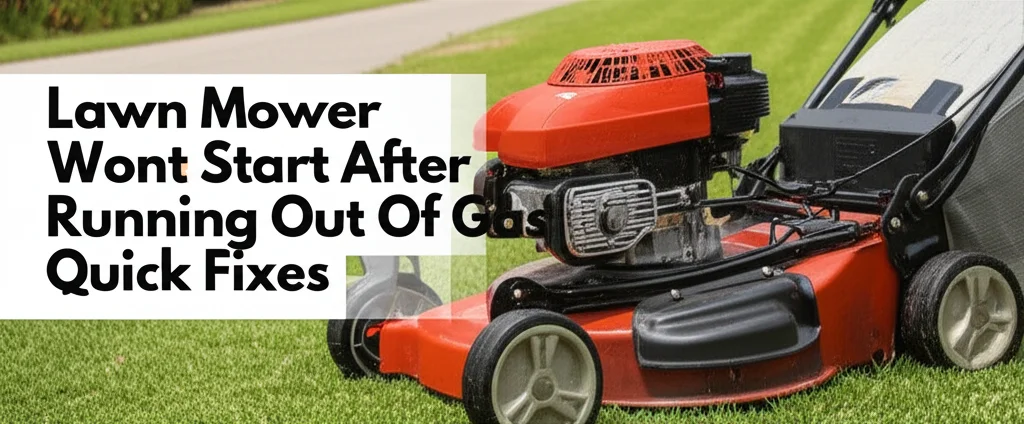· Lawn Mower Maintenance · 11 min read
Lawn Mower Wont Start After Running Out Of Gas Quick Fixes

Lawn Mower Won’t Start After Running Out of Gas: Quick Fixes
Running out of gas in the middle of mowing can be frustrating, but what’s even more aggravating is when your lawn mower won’t start after running out of gas.
This common problem affects thousands of homeowners every season, leaving them scratching their heads and wondering what went wrong.
Whether you’re dealing with a push mower, riding mower, or zero-turn model, the solution often involves understanding how fuel systems work and addressing air pockets that can form when the tank runs dry.
Key Takeaways
• Air locks are the primary culprit when lawn mowers won’t start after running out of gas
• Prime the carburetor by filling it with fresh fuel to eliminate air bubbles
• Check fuel lines for clogs or damage that may prevent proper fuel flow
• Clean the carburetor if the mower has been sitting with old gas
• Replace fuel filters and spark plugs if standard troubleshooting fails
• Prevention through proper fuel management saves time and frustration
Quick Answer: When a lawn mower won’t start after running out of gas, it’s usually due to an air lock in the fuel system. Prime the carburetor, check fuel lines for blockages, and ensure fresh gas reaches the engine. Most issues resolve with proper priming and patience.
Understanding Why Lawn Mowers Won’t Start After Running Out of Gas
When your lawn mower runs completely out of fuel, several mechanical issues can prevent it from restarting even after refueling. The most common problem is an air lock in the fuel system. As the gas tank empties, air enters the fuel lines and carburetor, creating pockets that block fuel flow to the engine.
Modern lawn mowers rely on a continuous flow of gasoline from the tank through fuel lines to the carburetor, where it mixes with air for combustion. When this flow is interrupted by running out of gas, the system needs to be “primed” or purged of air before normal operation can resume.
Additionally, running a mower until it’s completely dry can cause fuel residue to thicken in the carburetor jets and passages. This is especially problematic if the mower sits for extended periods after running out of gas, as evaporation leaves behind sticky deposits that can clog these tiny openings.
The fuel pump (in riding mowers) or gravity-fed system (in push mowers) also becomes compromised when air replaces fuel in the lines. This disruption requires specific steps to restore proper fuel delivery and get your mower running again.
Step-by-Step Troubleshooting Guide
Initial Checks and Preparation
Before diving into complex repairs, start with these basic steps that resolve most fuel-related starting issues:
Safety First: Ensure the mower is on level ground, the spark plug wire is disconnected, and you’re working in a well-ventilated area away from heat sources.
Add Fresh Fuel: Fill the tank with clean, fresh gasoline. Avoid using gas that’s been stored for more than 30 days, as stale fuel can compound starting problems. If you’re unsure about fuel age, drain the old gas and start with fresh fuel mixed with a fuel stabilizer.
Check the Fuel Shut-off Valve: Many riding mowers have a fuel shut-off valve near the tank. Ensure it’s in the “ON” or “OPEN” position. This simple oversight is responsible for many “won’t start” diagnoses.
Inspect Fuel Lines: Look for obvious damage, kinks, or disconnections in the fuel lines running from the tank to the carburetor. Cracked or loose lines will prevent proper fuel flow and may need replacement.
Priming the Carburetor System
The most critical step in resolving air lock issues is properly priming the carburetor. This process varies depending on your mower type:
For Push Mowers with Primer Bulbs: Press the primer bulb 3-5 times slowly until you feel resistance and see fuel in the clear fuel lines. Don’t over-prime, as this can flood the engine and make starting more difficult.
For Mowers Without Primer Bulbs: Remove the air filter cover and carefully pour a small amount (about a teaspoon) of fresh gasoline directly into the carburetor throat. This provides immediate fuel for initial combustion while the fuel system reprimes itself.
For Riding Mowers: Many riding mowers don’t have manual primers. Instead, try cranking the engine for 10-15 seconds at a time with 30-second breaks between attempts. This action helps draw fuel through the system and eliminate air pockets.
After priming, reconnect the spark plug wire and attempt to start the mower. It may take several attempts as the fuel system fully purges air and establishes consistent flow.
Common Issues and Advanced Solutions
Carburetor Problems and Cleaning
If basic priming doesn’t resolve the issue, the carburetor may need attention. Running out of gas can cause fuel residue to dry and clog carburetor jets, particularly the pilot jet that controls idle fuel flow.
Signs of Carburetor Issues:
- Engine starts but immediately dies
- Rough idling or surging
- Engine only runs with choke engaged
- Black smoke from exhaust
Cleaning Process: Remove the carburetor bowl and inspect for debris, water, or thick fuel residue. Clean all passages with carburetor cleaner spray and compressed air. Pay special attention to the main jet and pilot jet, which are easily clogged by fuel deposits.
For severe blockages, you may need to remove jets entirely and soak them in carburetor cleaner overnight. Always use the correct size drill bits or jet cleaning tools to avoid damaging these precision components.
Fuel System Component Replacement
Sometimes running out of gas reveals underlying fuel system problems that need component replacement:
Fuel Filter Replacement: A clogged fuel filter can prevent adequate fuel flow, especially after the system has been starved of gas. Replace the inline fuel filter if it appears dirty or hasn’t been changed in over a year.
Fuel Pump Issues: Riding mowers with mechanical fuel pumps may develop diaphragm tears or valve problems that become apparent after running out of gas. Test the pump by disconnecting the fuel line at the carburetor and cranking the engine - you should see steady fuel pulses.
Fuel Line Replacement: Old fuel lines can develop internal restrictions or collapse when subjected to vacuum pressure. If lines appear cracked, hardened, or discolored, replacement is the best solution.
Similar starting issues can occur with other lawn equipment, and you might find helpful information in guides about pressure washers that won’t start after running out of gas or general lawn mower starting problems.
Brand-Specific Solutions and Tips
Toro Lawn Mower Starting Issues
Toro mowers, including the popular Recycler series, have specific quirks when restarting after running out of gas. The Toro Personal Pace system can make priming more challenging because the self-propel mechanism affects engine timing.
Toro-Specific Steps:
- Engage the blade control bar while priming
- Use the electric start feature (if equipped) for longer cranking periods
- Check the fuel/oil mixture in 2-cycle Toro models
Many Toro starting problems stem from the ReadyStart system, which eliminates the choke but requires precise fuel delivery. If your Toro lawn mower won’t stay running after refueling, the ReadyStart sensor may need cleaning or replacement.
Craftsman and Husqvarna Models
Craftsman riding mowers often experience fuel pump issues after running dry. The mechanical fuel pump relies on engine vacuum, and air in the system can cause pump failure symptoms.
Craftsman Troubleshooting:
- Check the fuel pump diaphragm for tears
- Verify fuel pump mounting bolts are tight
- Test fuel pump output pressure with a gauge
Husqvarna mowers may have additional safety features that prevent starting after fuel starvation. The low-oil sensor or seat safety switch can create starting problems that mimic fuel issues. For detailed troubleshooting, check guides specific to Husqvarna riding lawn mower starting problems.
Cub Cadet and Zero-Turn Mowers
Zero-turn mowers like Gravely and Cub Cadet models have more complex fuel systems due to their larger engines and multiple fuel pumps. After running out of gas, these mowers often require longer priming periods and may need professional attention for fuel system bleeding.
Zero-Turn Specific Issues:
- Multiple fuel filters that may need simultaneous replacement
- Electric fuel pumps that can vapor lock
- Complex fuel line routing that traps air bubbles
If you’re dealing with Cub Cadet starting issues, remember that these commercial-grade mowers often have redundant safety systems that can complicate diagnosis.
Prevention Strategies and Best Practices
Fuel Management Tips
Preventing the “won’t start after running out of gas” problem begins with proper fuel management throughout the mowing season.
Fuel Storage Best Practices:
- Use fresh gasoline within 30 days of purchase
- Add fuel stabilizer to extend storage life to 12 months
- Store fuel in approved containers away from heat and moisture
- Avoid ethanol blends above 10% (E10) in small engines
Pre-Season Preparation:
- Drain old fuel before the first start of the season
- Replace fuel filters annually
- Check fuel lines for cracks or deterioration
- Clean the carburetor if the mower has been stored with fuel
Regular Maintenance Schedule
Implementing a regular maintenance routine prevents many fuel-related starting problems:
Monthly During Season:
- Check fuel level before each use
- Inspect fuel lines for damage
- Clean debris from fuel tank cap and screen
Seasonal Maintenance:
- Replace spark plug annually
- Clean or replace air filter
- Service carburetor if starting issues develop
- Check fuel pump operation on riding mowers
End-of-Season Storage:
- Run mower dry or treat fuel with stabilizer
- Change oil before storage
- Clean entire fuel system if storing with fuel
For comprehensive maintenance guidance, resources about lawn mower maintenance after winter storage provide valuable seasonal tips.
When to Seek Professional Help
While many fuel-related starting problems can be resolved with DIY troubleshooting, certain situations require professional intervention:
Professional Service Indicators:
- Repeated starting problems despite following troubleshooting steps
- Fuel system leaks or damaged components
- Engine damage from running lean (too little fuel)
- Complex carburetor rebuilds or fuel pump replacement
Cost Considerations: Professional lawn mower service typically costs $75-150 for fuel system diagnosis and basic repairs. Compare this cost against your mower’s value and your comfort level with mechanical work.
Warranty Concerns: If your mower is under warranty, attempting DIY repairs may void coverage. Check your warranty terms before disassembling fuel system components.
Some starting issues may indicate more serious problems, such as engine damage from hitting obstacles or ignition system failures that require professional diagnosis.
Frequently Asked Questions
Why won’t my lawn mower start after running out of gas? The most common cause is an air lock in the fuel system. When the tank empties completely, air enters the fuel lines and carburetor, preventing proper fuel flow. Prime the carburetor and check fuel lines for blockages to restore normal operation.
Is it bad to let your lawn mower run out of gas? While not immediately damaging, running out of gas can cause several problems including air locks, fuel residue buildup in the carburetor, and potential fuel pump strain. It’s better to refuel before the tank empties completely.
How do I start an engine after running out of gas? Add fresh fuel, prime the carburetor by pressing the primer bulb 3-5 times, and attempt to start. If there’s no primer bulb, add a small amount of gas directly to the carburetor throat. Be patient as it may take several attempts to purge air from the system.
Why does my riding mower turn over but won’t start after running out of gas? This typically indicates the starter and battery are working, but fuel isn’t reaching the engine. Check the fuel shut-off valve, prime the fuel system, and verify the fuel pump is operating correctly. The fuel filter may also need replacement.
How long should I wait before trying to start after refueling? Wait 2-3 minutes after refueling to allow fuel to settle and reach the carburetor through gravity feed. For riding mowers with fuel pumps, you can attempt starting immediately after priming, but expect several cranking cycles.
Can old gas cause starting problems after running out? Yes, stale gasoline (over 30 days old) can create starting difficulties even after refueling. Old gas may not ignite properly and can leave deposits that clog fuel system components. Always use fresh fuel when possible.
What should I do if priming doesn’t work? If basic priming fails, check for clogged fuel filters, damaged fuel lines, or carburetor blockages. The problem may require carburetor cleaning, component replacement, or professional service for complex fuel system issues.
Final Words
Dealing with a lawn mower that won’t start after running out of gas is frustrating but usually manageable with the right approach. Most issues stem from air locks in the fuel system that can be resolved through proper priming techniques and patience. Remember to use fresh gasoline, maintain your fuel system regularly, and address problems promptly to avoid more costly repairs.
The key to success lies in understanding your specific mower’s fuel system and following systematic troubleshooting steps. Start with simple solutions like checking fuel valves and priming the carburetor before moving to more complex repairs. When in doubt, don’t hesitate to consult your owner’s manual or seek professional help.
Take action today by implementing preventive maintenance practices that will keep your lawn mower running reliably all season long. Your future self will thank you when your mower starts on the first pull every time.
- lawn mower repair
- running out of gas
- lawn mower troubleshooting


